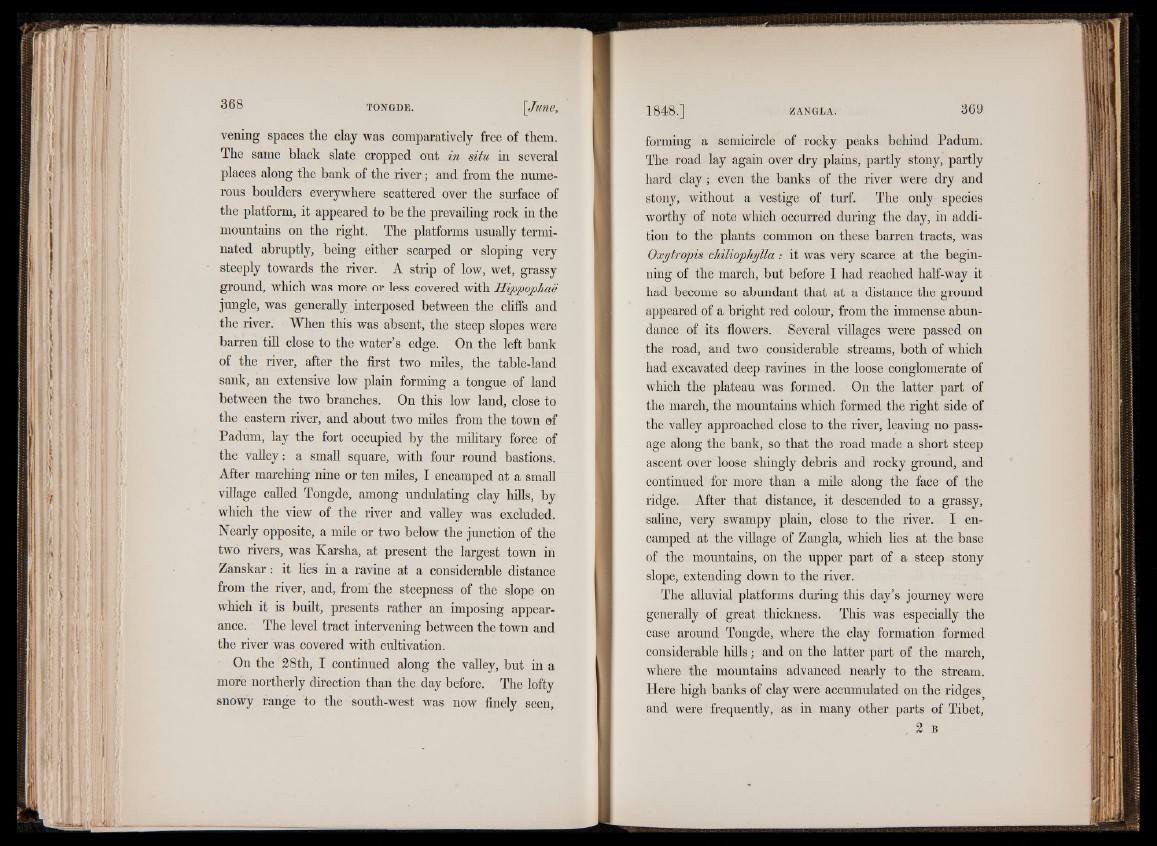
vening spaces the clay was comparatively free of them.
The same black slate cropped out in situ in several
places along the bank of the river ; and from the numerous
boulders everywhere scattered over the surface of
the platform, it appeared to be the prevailing rock in the
mountains on the right. The platforms usually terminated
abruptly, being either scarped or sloping very
steeply towards the river. A strip of low, wet, grassy
ground, which was more or less covered with Hippophae
jungle, was generally interposed between the cliffs and
the river. When this was absent, the steep slopes were
barren till close to the water’s edge. On the left bank
of the river, after the first two miles, the table-land
sank, an extensive low plain fo rm in g a tongue of land
between the two branches. On this low land, close to
the eastern river, and about two miles from the town of
Padum, lay the fort occupied by the m ilita ry force of
the valley : a small square, with four round bastions.
After marching nine or ten miles, I encamped at a small
village called Tongde, among undulating clay hills, by
which the view of the river and valley was excluded.
Nearly opposite, a mile or two below the junction of the
two rivers, was Karsha, at present the largest town in
Zanskar : it lies in a ravine at a considerable distance
from the river, and, from the steepness of thè slope on
which it is built, presents rather an imposing appearance.
The level tract intervening between the town and
the river was covered with cultivation.
On the 28th, I continued along the valley, but in a
more northerly direction than the day before. The lofty
snowy range to the south-west was now finely seen,
forming a semicircle of rocky peaks behind Padum.
The road lay again over dry plains, partly stony, partly
hard clay; even the banks of the river were dry and
stony, without a vestige of turf. The only species
worthy of note which occurred during the day, in addition
to the plants common on these barren tracts, was
Oxytropis ehiliophylla: it was very scarce at the beginning
of the march, but before I had reached half-way it
had become so abundant that at a distance the ground
appeared of a bright red colour, from the immense abundance
of its flowers. Seyeral villages were passed on
the road, and two considerable streams, both of which
had excavated deep ravines in the loose conglomerate of
which the plateau was formed. On the latter part of
the march, the mountains which formed the right side of
the valley approached close to the river, leaving no passage
along the bank, so that the road made a short steep
ascent over loose shingly debris and rocky ground, and
continued for more than a mile along the face of the
ridge. After that distance, it descended to a grassy,
saline, very swampy plain, close to the river. I encamped
at the village of Zangla, which lies at the base
of the mountains, on the upper part of a steep stony
slope, extending down to the river.
The alluvial platforms during this day’s journey were
generally of great thickness. This was especially the
case around Tongde, where the clay formation formed
considerable hills; and on the latter part of the march,
where the mountains advanced nearly to the stream.
Here high banks of clay were accumulated on the ridges^
and were frequently, as in many other parts of Tibet,